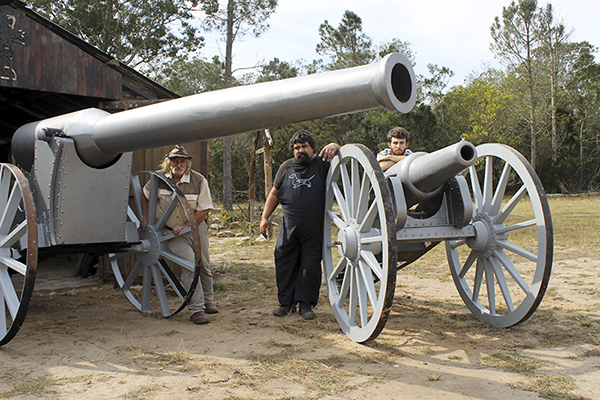Through a rusty gate somewhere outside Makhanda, a narrow and winding dirt road watched over by an army of trees leads you to a stone barn. Light filters through decorated window arches to reveal two monsters of the like that struck terror into the hearts of British soldiers.
One, the French-origin 155 mm Creusot Long Tom with its 10km firing range was so lethal that in conceding positions during the South African War of 1899-1902, the Boers destroyed the only four brought into the country rather than have them fall into the hands of the enemy. Its total weight is around 6 500kg and the barrel alone is 4.2 metres long.
Its more modest companion has a barrel weighing a mere ton (roughly) – that’s without the platform and wheels. The near identical replica of a 6.3-inch rifled muzzle loading howitzer is modelled on a pair on display outside the town hall in Ladysmith, KZN.
Castor and Pollux, named after the twin sons of the god Zeus of Greek myth, were shipped to Port Elizabeth and sent to Ladysmith ahead of the famous siege. One of them damaged a Boer Long Tom and a few weeks later, in revenge, the Long Tom severely damaged Castor.
While Wikipedia still records the guns standing outside the Ladysmith Town Hall as the ‘Castor and Pollux’ that served the British army during the Siege of Ladysmith, South African history researcher MC Heunis discovered through checking the serial numbers that only one was a British weapon. The other was in fact an identical gun used by the Boers during the same war. He writes at the end of his article documenting the discovery, “Once sworn enemies, today the two old veterans are resting in peace, side by side.”
When here in Makhanda (Grahamstown) Basil Mills was asked to make up replicas of survivor Pollux and the Long Tom that got its twin, he jumped at the challenge.
“It took us four months to build these,” said the founder of SABRE, the South African Battle Re-enactment Society, as he and co-creators Ben Coetzee and Lantis van Boom (‘Boom’) strained to roll the giants out into the light for a photograph.
Mills operates a traditional metalwork forge and that’s where these extraordinary monuments to history were welded and moulded. The guns are definitely not operational.
“The barrels are made of 4mm iron for a start,” Mills saiid. “You could never fire anything from that.”
The 7.5-metre Long Tom weighed more than 6 tons but the replica is just on three. The Howitzer replica weighs just on one tone and the original is just short of two.
The original Long Tom is a breech loader (you put the gunpowder in from the back); the RML (rifled muzzle-loading) howitzer was loaded through the muzzle, or front of the barrel.
The cannons are made to scale.
“We used a combination of old photographs and some rather vague old imperial plans to get the proportions right,” Mills said.
The team made the wheels themselves using the old craft of blacksmithing and welding.
“There was lots of forge work using old wagon parts,” Mills said.
Basil did the planning and shaping; Boom did the welding and Ben was the helpful handlanger.
“One of the purposes of SABRE is to teach skills through apprenticeship,” Mills said.
Seeing and touching the machines – even in replica – makes one realise the scale of the equipment, supplies and logistics of some of the early battles fought over South African resources.
“It’s the opportunity to “see” that history that puts places on the map for people interested in military history,” Mills said. “The fact that this was a garrison town is part of its history.”
Next year is the centenary of the Battle of Egazini.
“The Western Cape and KwaZulu-Natal get a lot of exposure and tourism from their battlefields tours,” Mills said. “It’s a huge industry there.
“Yet here we have everything that those tourists could want to see. They can visit our museums, the old signal forts – all of that is still here.”
Mills said he planned to take part in events to commemorate the Battle of Egazini. The 200-year anniversary is on 22 April 2019. If nothing else, he will symbolically fire the original half-pounder and 4-pounder cannons that he brings out for special occasions.
- More about the Long Tom here: https://en.wikipedia.org/wiki/155_mm_Creusot_Long_Tom
- More about the RML 6.3-inch howitzer here: https://en.wikipedia.org/wiki/RML_6.3-inch_howitzer
- Semi-random fact: The Cape Town based Cannon Association of South Africa plan to help the SA Navy fire a massive 12-ton 9-inch Rifled Muzzle Loader (RML) cannon two more times in 2018: The most recent was Heritage Day (24 September). Coming up are Armistice Day (11 November) and the Day of Reconciliation (16 December).


